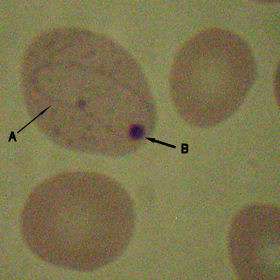Cabot rings

Cabot rings are thin, red-violet staining, threadlike strands in the shape of a loop or figure-8 that are found on rare occasions in red blood cells (erythrocytes). They are believed to be microtubules that are remnants from a mitotic spindle, and their presence indicates an abnormality in the production of red blood cells.[1]
Cytologic appearance
Cabot rings appear as ring, figure-8 or loop-shaped structures on microscopy. Cabot rings stain red or purple with Wright's stain.
Associated conditions
Cabot rings have been observed in a handful of cases in patients with pernicious anemia, lead poisoning, certain other disorders of red blood cell production (erythropoiesis).[1]
History
They were first described in 1903 by American physician, Richard Clarke Cabot (1868-1939).
References
Further reading
- Kass, L (July 1975). "Origin and composition of Cabot rings in pernicious anemia.". American Journal of Clinical Pathology. 64 (1): 53–7. PMID 1155375.
External links
This article is issued from Wikipedia - version of the 3/7/2016. The text is available under the Creative Commons Attribution/Share Alike but additional terms may apply for the media files.
